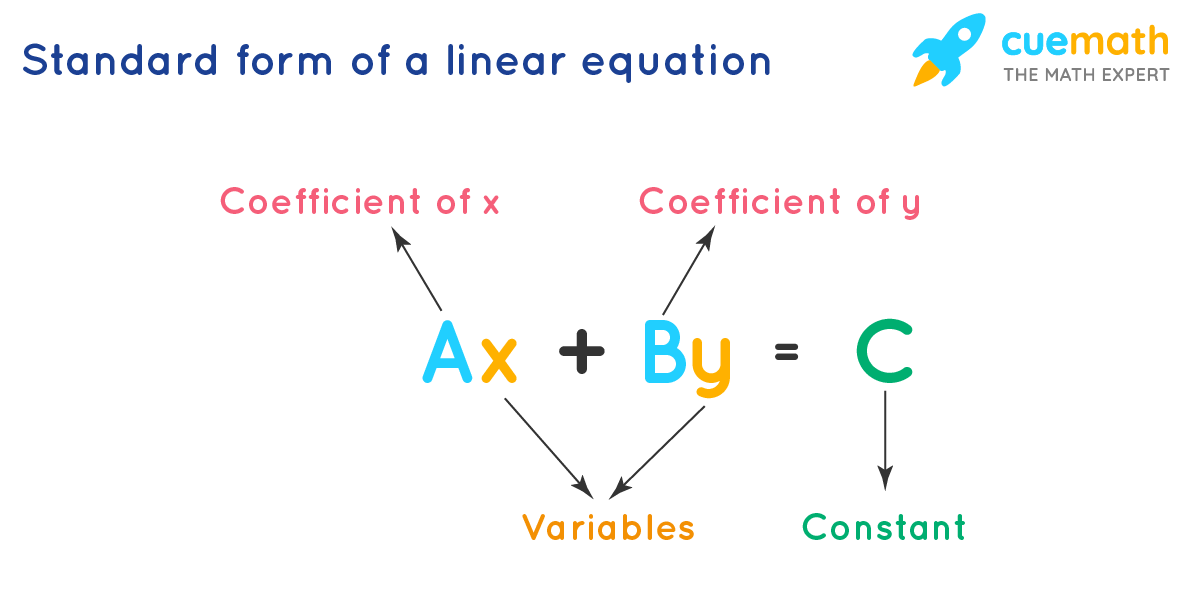2 4 Practice Writing Linear Equations
Linear Equations
Linear equations are nothing but yet another subset of "equations". Any linear calculations requiring more than one variable can be done with the help of linear equations. The standard form of a linear equation in one variable is of the form ax + b = 0. Here, x is a variable, and a and b are constants. While the standard form of a linear equation in two variables is of the form ax + by = c. Here, x and y are variables, and a, b and c are constants.
| 1. | What is Linear Equation? |
| 2. | Understanding Linear Equation |
| 3. | Linear Equation Formula |
| 4. | Linear Equation Graph |
| 5. | How to solve Linear Equations? |
What is Linear Equation?
A mathematical statement that has an equal to the "=" symbol is called an equation. Linear equations are equations of degree 1.
Linear Equation Definition
A linear equation is an equation that is written for two different variables. This equation will be a linear combination of these two variables, and a constant can be present. Surprisingly, when any linear equation is plotted on a graph, it will necessarily produce a straight line - hence the name: Linear equations.
Linear Equation Examples
A linear equation can be written in different ways. Any simple equation in x and y can be termed as a linear equation if it follows a certain set of rules. For example, the highest (and the only) degree of both - x and y - variables in the equation should be 1. Other than that, constants (zero degree variables) can be there. In order to have a better understanding of which equations can be termed as linear or not, have a look at the following equations.
| Equations | Linear or Non-Linear |
| y = 8x - 9 | Linear |
| y = x2 - 7 | Non-Linear |
| √y + x = 6 | Non-Linear |
| y + 3x - 1 = 0 | Linear |
| y2 - x = 9 | Non-Linear |
Understanding Linear Equation
Linear Equations are a wide variety of equations altogether. There can be linear equations in one variable, linear equations in two variables, and so on. In every equation, one thing remains constant: The highest (and the only) degree of all variables in the equation should be 1. Other than that, constants (zero degree variables) can be there. Let us have a look at the following game called "Mind reader" that will help you in understanding linear equations in a better way.
Appu created a game called "Mind Reader". He wants to play it with his friends. So he asks one of his friends, Kaira, to think of a number, multiply it by 2, and subtract 5 from it. He then asks her the final result. Kaira says, "it is 13", so Appu instantly says that the number Kaira thought of initially was 9. Kaira nods and Appu's friends including Kaira are surprised! Everybody wants to know how the game "Mind Reader" works. Do you know how it works? By the end of this short lesson, you will understand how it works.
Linear Equation Formula
Linear equation formula is upon case to case and based on the number of variables and the variables used themselves. Firstly, the variables should be independent of each other. Suppose you have x as a variable, then you can't keep x 2 as another variable. Secondly, the highest (and the only) degree of all variables in the equation should be 1. Other than that, constants (zero degree variables) can be there. Let us have a look at the standard form of a linear equation with variables x and y:

Linear Equation Graph
The graph of a linear equation in one variable x forms a vertical line parallel to the y-axis and vice-versa, whereas the graph of a linear equation in two variables x and y forms a straight line. The reason an equation of degree one is called a linear equation is that its geometrical representation is a straight line. Given above are a few examples of how we plot linear equations on a graph.

How to solve Linear Equations?
Let's have a look at how to solve any equation. An equation is like a weighing balance with equal weights on both sides. If we add or subtract the same number from both sides of an equation, it still holds. Similarly, if we multiply or divide the same number on both sides of an equation, it still holds. Consider the equation, 3x - 2 = 4. We will perform mathematical operations on the LHS and the RHS so that the balance is not disturbed. Now let's add 2 on both sides to reduce the LHS to 3x. This will not disturb the balance.The new LHS is 3x - 2 + 2 = 3x and the new RHS is 4 + 2 = 6. Now let's divide both sides by 3 to reduce the LHS to x. Thus, we have x = 2. This is just one way of solving such equations. One another and more efficient way is to solve linear equations graphically.

Important Points
- The values of the variable that makes a linear equation true are called the solution or root of the linear equation.
- The solution of a linear equation is unaffected if the same number is added, subtracted, multiplied, or divided into both sides of the equation.
- The graph of a linear equation in one or two variables is a straight line.
-
Example 1:A one-day International cricket match was organized in Nagpur. India and Sri Lanka were the two teams. Two Indian batsmen together scored 189 runs. Can you express this information in the form of a linear equation?
Solution:
Let us use the variables x and y to denote the number of runs scored by each batsman. We know that they scored 189 runs together. Thus, we can say that the total of x and y is 189.
Therefore, two batsmen scored 189 runs.
-
Example 2: Bansi loves to collect two cents and five cents coins in her piggy bank. She knows that the total sum in her piggy bank is $0.77 and it has 3 times as many two-rupee coins as five-rupee coins in it. She wants to know the exact number of two-cent coins and five-cent coins in her piggy bank. Can you help her find the count?
Solution :
Let the number of five-cent coins be x. The number of two-cent coins will be 3x. Total amount = 5x + (2 × 3x).
Type Number Value (cents) = Total Value (cents) five-cent coins x 5 5x five-cent coins 3x 2 2(3x) = 6x 77 According to the information we have, 5x + (2 × 3x) = 77. Thus, 11x = 77 ---> x = 7. Since, two cent coins are 3x, we can say that they are 3(7) = 21 coins.
Therefore, she has 7 five-rupee & 21 two-rupee coins.
go to slidego to slide

Have questions on basic mathematical concepts?
Become a problem-solving champ using logic, not rules. Learn the why behind math with our Cuemath experts
Book a Free Trial Class
FAQs on Linear Equation
What is a Linear Equation? Explain with an Example.
An equation of the form ax + by = c is called a linear equation. Here, x and y are variables, and a, b and c are constants. Examples of the linear equation are:
- y = 4x - 3
- 7y - 5x = 1
- y = 2
What is the Formula for a Linear Equation?
The standard form of a linear equation in one variable is of the form ax + b = 0. Here, x is a variable, and a and b are constants. While the standard form of a linear equation in two variables is of the form ax + by = c. Here, x and y are variables, and a, b and c are constants.
What is a Simple Definition of a Linear Equation?
An equation that can be written in the form ax + by = c is called a linear equation. This is the standard form of a linear equation in two variables x and y.
Why is it Called a Linear Equation?
It is called a linear equation, because if you try to plot the graph of the given equation with variables x and y on a graph with axes as x and y, you would get a line as your result. Hence, it is called a linear equation.
How do you Solve Linear Equations? Give an Example.
We can try to solve a linear equation by moving the variable part to one side of the equation, and the numeric part on the other one. For example, x - 1 = 5 - 2x can be solved by taking numeric parts on the Right-hand side of the equation, while keeping the variables on the left side. Hence, we get x + 2x = 5 + 1. Thus, 3x = 6. From here we can solve by saying that x = 2.
What is a Linear Equation in Algebra?
A linear equation in algebra is an equation that can be written in the form ax + by = c.
Can Linear Equations have Fractions?
Yes, linear equations can have fractions only as long as the denominator in the fractional part is a constant value. The variables can not be a part of the denominator of any fraction in a linear equation.
2 4 Practice Writing Linear Equations
Source: https://www.cuemath.com/algebra/linear-equations/
Posted by: coxantaistry.blogspot.com

0 Response to "2 4 Practice Writing Linear Equations"
Post a Comment